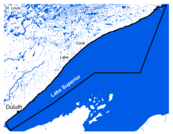Lower Shore: Duluth to Two Harbors
The lake was windy this week, keeping many of the smaller fishing boats ashore. Surface water temps were in the upper 60’s for most of the week. Anglers running lines 120-180 feet down in 200+ feet of water had the most success for Lake Trout. Trolling flashy bright spoons caught the most fish, but some anglers found a lot of success jigging in 130-160 feet of water, especially in the Larsmont area. The Lake Trout were on the smaller side, with a lot of 15-16 inchers coming into the docks. Salmon of all species were few and far between with seemingly no pattern to when or where they were caught. Anglers at Rice’s Point reported catching more walleye off the docks in recent days.
Upper Shore: Twin Points to Hovland
Surface water temps were 54-60 °F from all stations. The Lake Trout fishing was variable depending on location. Some anglers found good fishing several miles offshore, while those fishing in the deep water close to shore found fewer fish. Lake Trout were largely suspended deep in the water column, especially further from shore. Running flashy spoons other lures on downriggers, at specific depths where fish were spotted on electronics produced the most fish. Large Lake Trout from 24 to 34 inches were common from all stations and good numbers of 4-10 pounders. Shore fishing was very slow for Lake Trout as they have not moved close to shore yet. Salmon were quite sparse except for a few Pink Salmon and the occasional report of a nice Chinook or Coho. Pink salmon were spotted in several Upper Shore rivers and are likely to start running in greater numbers soon.
Management Updates
Anglers have seen an increase in the number of Sea Lamprey and Sea Lamprey wounds on fish caught in Lake Superior this year. The U.S. Fish & Wildlife Service and Fisheries and Oceans Canada are the two Federal agencies tasked with Sea Lamprey assessment and control under the auspices of the Great Lakes Fishery Commission. In 2020, thirty tributaries around Lake Superior were scheduled to be treated to kill larval Sea Lamprey before they become parasitic and feed on fish. However, only 10 of those tributaries were treated due to travel restrictions associated with the COVID-19 pandemic. Unfortunately, this increase in adult Sea Lamprey abundance, increased wounding on Lake Trout, and an increase in the number of fish killed (each Sea Lamprey consumes 40 pounds of fish in its lifetime) was anticipated but should be short-lived. Treatments on Lake Superior tributaries have since resumed and anglers should notice fewer Sea Lamprey and Sea Lamprey wounds on fish over the next few years.
For more information on Sea Lamprey control in the Great Lakes check out the Great Lakes Fishery Commission website and the most recent report Sea Lamprey Control in the Great Lakes 2023 from the U.S. Fish and Wildlife Service and Fisheries and Oceans Canada.
Helpful Links
 Questions?
Visit us online at mndnr.gov
If this message was shared with you, sign up to receive it at the link above.
Email us at Lake Superior fishing report
Give us a call at 218-302-3277
Fishing report hotline at 218-302-3293
Report suspicious activity at 800-652-9093
|